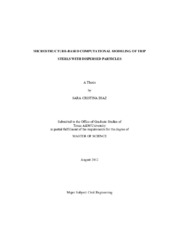| dc.description.abstract | Industries, such as the automotive industry, aim to increase the reliability of their products to match the demands and assure the safety of their clients. The proposition of a third generation advanced high strength steel is introduced in this study. The ideas surrounding the behavior of transformation induced plasticity (TRIP) steels and particle reinforced composites are combined and investigated. A finite element model (FEM) is created to investigate the effects of dispersed ceramic particles with varying parameters throughout a TRIP steel microstructure and identify key mechanisms responsible for achieving simultaneous enhancements in strength and ductility. The ceramic material utilized and volume fraction of the ceramic particles dispersed throughout the representative volume element (RVE) are the two varying parameters investigated in this study.
Through observing the equivalent plastic strain (PEEQ) distribution at different strain levels up to 100%, evidence of failure controlled by strain localization throughout the ferrite matrix is more prevalent through the softer, austenitic microstructures with 5% or less ceramic particle inclusions. On the other hand, the presence of the hard martensite constituents, or 10% volume fraction of ceramics in an austenitic structure, proposed that failure would engender due to void nucleation at the harder constituent/ferrite interfaces. These voids will then grow and coalesce throughout the microstructure, resulting in a crack.
The increased addition of ceramic inclusions also illustrates a simultaneous enhancement in the ultimate tensile strength and ultimate strain in all microstructures. Tensile strength increases by a total of 18% with 10% volume ceramic particles in a TRIP steel microstructure. Between utilizing silicon carbide, cementite, zirconia and aluminum oxide ceramic particles, the microstructure that illustrated the most optimal enhanced performance in strength and ductility was the 10% volume fraction aluminum oxide particle reinforced TRIP steel composite. | en |


